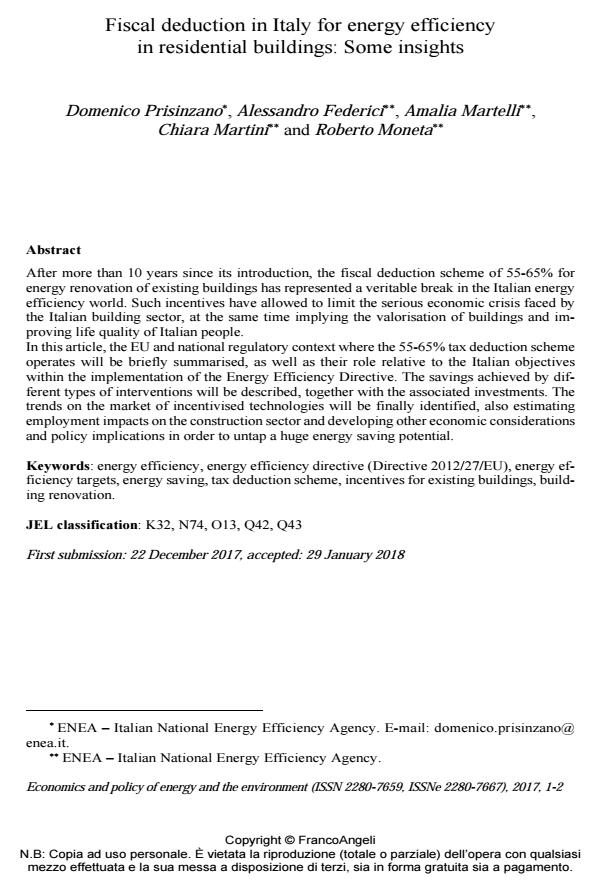Fiscal deduction in Italy for energy efficiency in residential buildings: Some insights
Journal title ECONOMICS AND POLICY OF ENERGY AND THE ENVIRONMENT
Author/s Domenico Prisinzano, Alessandro Federici, Amalia Martelli, Chiara Martini, Roberto Moneta
Publishing Year 2017 Issue 2017/1-2 Language English
Pages 15 P. 15-29 File size 656 KB
DOI 10.3280/EFE2017-001002
DOI is like a bar code for intellectual property: to have more infomation
click here
Below, you can see the article first page
If you want to buy this article in PDF format, you can do it, following the instructions to buy download credits

FrancoAngeli is member of Publishers International Linking Association, Inc (PILA), a not-for-profit association which run the CrossRef service enabling links to and from online scholarly content.
After more than 10 years since its introduction, the fiscal deduction scheme of 55-65% for energy renovation of existing buildings has represented a veritable break in the Italian energy efficiency world. Such incentives have allowed to limit the serious economic crisis faced by the Italian building sector, at the same time implying the valorisation of buildings and improving life quality of Italian people. In this article, the EU and national regulatory context where the 55-65% tax deduction scheme operates will be briefly summarised, as well as their role relative to the Italian objectives within the implementation of the Energy Efficiency Directive. The savings achieved by different types of interventions will be described, together with the associated investments. The trends on the market of incentivised technologies will be finally identified, also estimating employment impacts on the construction sector and developing other economic considerations and policy implications in order to untap a huge energy saving potential.
Keywords: Energy efficiency, energy efficiency directive (Directive 2012/27/EU), energy efficiency targets, energy saving, tax deduction scheme, incentives for existing buildings, building renovation.
Jel codes: K32, N74, O13, Q42, Q43
- Assoclima (2017). Indagine statistica sul mercato dei componenti per impianti di condizionamento dell’aria -- file:///C:/Users/alessandro/Downloads/Rilevazione_Assoclima-2016-v2.pdf.
- Autorità di Regolazione per Energia Reti e Ambiente (2014). Delibera 205/2014/R/eel. -- https://www.arera.it/allegati/docs/14/205-14ti.pdf.
- Chamber of Deputies (2017). Il recupero e la riqualificazione energetica del patrimonio edilizio: una stima dell’impatto delle misure di incentivazione – Quinta edizione. -- http://documenti.camera.it/leg17/dossier/pdf/Am0051d.pdf.
- ENEA (2016). Energy Efficiency Annual Report. -- http://www.enea.it/it/seguici/pubblicazioni/pdf-volumi/raee-2016-versione-integrale.pdf (full report in Italian) and -- http://www.enea.it/it/seguici/pubblicazioni/pdf-volumi/executive-summary-2016-eng.pdf (executive summary in English).
- ENEA (2017a). Energy Efficiency Annual Report. -- http://www.enea.it/it/seguici/pubblicazioni/pdf-volumi/raee-2017.pdf (full report in Italian) and -- http://www.enea.it/it/seguici/pubblicazioni/pdf-volumi/raee-executive-summary-en.pdf (executive summary in English).
- ENEA (2017b). 65% Tax Deduction Scheme Annual Report. -- http://www.enea.it/it/seguici/pubblicazioni/pdf-volumi/detrazioni-65-2017.pdf (full report in Italian) and -- http://www.enea.it/it/seguici/pubblicazioni/pdf-volumi/detrazioni-65-executive-summary-2017-en.pdf (executive summary in English).
- International Energy Agency (2014). Energy Efficiency Market Report 2014. -- https://www.iea.org/publications/freepublications/publication/EEMR2014.pdf.
- Italian National Institute of Statistics (2011). 2011 general census. -- http://dati-censimentopopolazione.istat.it/Index.aspx?lang=it.
- Italian Parliament (2006). 2007 Budget Law. -- http://www.parlamento.it/parlam/leggi/06296l.htm.
- Italian Parliament (2016). 2017 Budget Law. -- http://www.gazzettaufficiale.it/eli/id/2016/12/21/16G00242/sg.
- Ministry of Economic Development (2013). Italy’s National Energy Strategy: for a more competitive and sustainable energy. -- http://www.sviluppoeconomico.gov.it/images/stories/documenti/SEN_EN_marzo2013.pdf.
- Ministry of Economic Development (2014a). Italian Energy Efficiency Action Plan. -- https://ec.europa.eu/energy/sites/ener/files/documents/ItalyNEEAP2014en.pdf.
- Ministry of Economic Development (2014b). Application of Article 7 of Directive 2012/27/EU on energy efficiency obligation schemes Notification of methodology. -- https://ec.europa.eu/energy/sites/ener/files/documents/article7_en_italy.pdf.
- Ministry of Economic Development (2017a). Piano d’Azione Italiano per l’Efficienza Energetica. -- https://ec.europa.eu/energy/sites/ener/files/documents/it_neeap_2017_it_1.pdf.
- Ministry of Economic Development (2017b). Relazione annuale sull’efficienza energetica: risultati conseguiti e obiettivi al 2020. -- http://www.sviluppoeconomico.gov.it/images/stories/documenti/Relazione-Annuale-Efficienza-Energetica-2017.pdf.
- Ministry of Economic Development (2017c). Strategia Energetica Nazionale. -- http://www.sviluppoeconomico.gov.it/images/stories/documenti/testo_della_StrategiaEnergeticaNazionale_2017.pdf (in Italian) and http://www.sviluppoeconomico.gov.it/images/stories/documenti/BROCHURE_ENG_SEN.PDF (brochure in English).
- UNICMI (2017). Rapporto sul mercato italian dell'Involucro Edilizio. -- http://www.unicmi.it/in_evidenza/in_evidenza/rapporto_unicmi_2017.html.
Domenico Prisinzano, Alessandro Federici, Amalia Martelli, Chiara Martini, Roberto Moneta, Fiscal deduction in Italy for energy efficiency in residential buildings: Some insights in "ECONOMICS AND POLICY OF ENERGY AND THE ENVIRONMENT" 1-2/2017, pp 15-29, DOI: 10.3280/EFE2017-001002